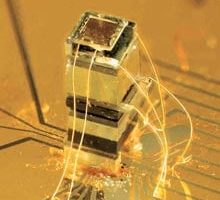Atomic Magnetometers

Magnetic fields are everywhere, from the human body to the metal in a buried land mine. Even molecules such as proteins generate their own distinctive magnetic fields. Both magnetic resonance imaging (MRI), which yields stunningly detailed images of the body, and nuclear magnetic resonance spectroscopy (NMR), which is used to study proteins and other compounds such as petroleum, rely on magnetic information. But the sensors currently used to detect these faint but significant magnetic fields all have disadvantages. Some are portable and cheap but not very sensitive; others are highly sensitive but stationary, expensive, and power-hungry.
Now John Kitching, a physicist at the National Institute of Standards and Technology in Boulder, CO, is developing tiny, low-power magnetic sensors almost as sensitive as their big, expensive counterparts. About the size of a fat grain of rice, the sensors are called atomic magnetometers. Kitching hopes that they will one day be incorporated into everything from portable MRI machines to faster and cheaper detectors for unexploded bombs.
The tiny sensors have three key components, stacked vertically on top of a silicon chip. An off-the-shelf infrared laser and an infrared photodetector sandwich a glass-and-silicon cube filled with vaporized cesium atoms. In the absence of a magnetic field, the laser light passes straight through the cesium atoms. In the presence of even very weak magnetic fields, though, the atoms’ alignment changes, allowing them to absorb an amount of light proportional to the strength of the field. This change is picked up by the photodetector. “It’s a simple configuration with extremely good sensitivity,” Kitching says.
Atomic magnetometers have been around for about 50 years; most have large, sensitive vapor cells, about the size of soda cans, made using glassblowing techniques. The most sensitive of these can detect fields on the order of a femtotesla–about one-fifty-billionth the strength of Earth’s magnetic field. Kitching’s innovation was to shrink the vapor cell to a volume of only a few cubic millimeters, decreasing power usage while keeping performance comparable.
Working with five other physicists, Kitching makes the vapor cells using micromachining techniques. They begin by using a combination of lithography and chemical etching to punch square holes three millimeters across into a silicon wafer. Then they clamp the silicon to a slip of glass and create a bond using high heat and a voltage, turning the square hole into a topless box with a glass bottom.
Inside a vacuum chamber, they use a tiny glass syringe to fill the box with vaporized cesium atoms; then they seal the box with another slip of glass at high heat. (This must be done in a vacuum because cesium reacts vigorously with water and oxygen.) Next, the physicists mount the finished vapor cell on a chip, along with the infrared laser and the photodetector. They pass a current through thin conductive films on the top and bottom of the cell to produce heat, which keeps the cesium atoms vaporized.
Kitching currently builds magnetometers a few at a time in the lab, but he has designed them with bulk manufacturing in mind. Many copies of each component are carved out simultaneously from a single silicon wafer. Several wafers, each containing multiple copies of a different component, could be layered one on top of the other. Then the stack could be sliced into multiple magnetometers.
Made in this inexpensive way, the low-power sensors could be set into portable, battery-powered imaging arrays. Such arrays could easily map out the strength and extent of magnetic fields; the more sensors in an array, the more information it can provide about an object’s location and shape. Soldiers, for example, could use such arrays to find unexploded bombs and improvised explosive devices more quickly and cheaply.
The tiny sensors could also revolutionize MRI and NMR. Both technologies rely on powerful, cumbersome, expensive magnets that require costly cooling systems. Because Kitching’s sensors can detect very weak magnetic fields, MRI and NMR machines incorporating them might be able to get good pictures using a magnet that’s much weaker–and therefore smaller and cheaper.
As a result, MRI could become more widely available. And for the first time, doctors could use it to examine patients with pacemakers or other metallic implants that can’t be exposed to powerful magnets. Portable systems might even be developed for use in ambulances or on battlefields. And NMR could move from the lab into the field, where it could help oil and mining companies assess promising underground deposits.
Kitching and his colleagues recently showed that the sensors can measure NMR signals produced by water. Much remains to be done, Kitching says, before the devices can resolve faint signals from multiple chemical structures–distinguishing, say, between several possible trace contaminants in a water sample. Likewise, portable MRI machines will take some work. But with Kitching’s miniaturized magnetometers, the challenge will shift from gathering magnetic information to interpreting it.
Keep Reading
Most Popular
Large language models can do jaw-dropping things. But nobody knows exactly why.
And that's a problem. Figuring it out is one of the biggest scientific puzzles of our time and a crucial step towards controlling more powerful future models.
How scientists traced a mysterious covid case back to six toilets
When wastewater surveillance turns into a hunt for a single infected individual, the ethics get tricky.
The problem with plug-in hybrids? Their drivers.
Plug-in hybrids are often sold as a transition to EVs, but new data from Europe shows we’re still underestimating the emissions they produce.
Google DeepMind’s new generative model makes Super Mario–like games from scratch
Genie learns how to control games by watching hours and hours of video. It could help train next-gen robots too.
Stay connected
Get the latest updates from
MIT Technology Review
Discover special offers, top stories, upcoming events, and more.